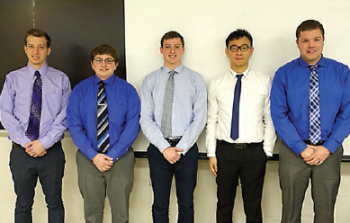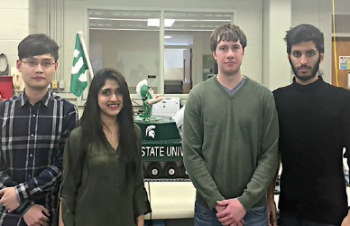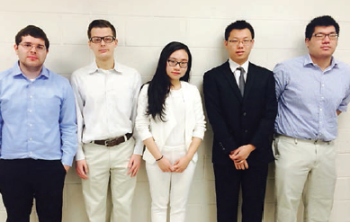Electrical Engineering
Projects
Electrical and Computer Engineering ECE 480 Senior Design is required of all electrical and computer engineering majors at MSU.
For information on becoming a project sponsor, please contact Gregg Motter.
The following are the project sponsors and projects for the spring of 2015:
MSU College of Engineering: Surgical Tool Utilized in Unsanitary Conditions
Surgical Site Infections (SSI) occur at the location where surgery was performed and can be a result of unsanitary surgical settings and practices. These infections can lead to extended hospitalization, treatment, and even death.
 In a study conducted by the Centers for Disease Control (CDC) in the United States from 2006-2008, there were over 16,000 surgical site infections which equated to an overall rate of 1.9% of all operative procedures. However, the prevalence of these infections drastically increases when compared with underdeveloped countries. A similar study conducted in India in 2007 showed 21.6% of patients suffered from surgical site infections. This is the result of improper sterilization methods, operating room ventilation, and availability of antimicrobials.
In a study conducted by the Centers for Disease Control (CDC) in the United States from 2006-2008, there were over 16,000 surgical site infections which equated to an overall rate of 1.9% of all operative procedures. However, the prevalence of these infections drastically increases when compared with underdeveloped countries. A similar study conducted in India in 2007 showed 21.6% of patients suffered from surgical site infections. This is the result of improper sterilization methods, operating room ventilation, and availability of antimicrobials.
The goal of this project is to create a surgical tool which is capable of suffusing antimicrobials continuously throughout a surgery to help improve the sanitization of the tool and reduce surgical infections experienced by a patient. A pump powered by a battery will utilize micro-channels to deliver the desired fluid to the tool at a calculated flow rate. The tool will be capable of functioning for a minimum of six hours and will be able to run for the duration of the surgery, minimizing the growth of bacteria.
Improving the sanitization of surgical tools utilized in unsanitary operating rooms can reduce surgical site infections experienced by patients which will decrease hospital stays, and ultimately save lives.
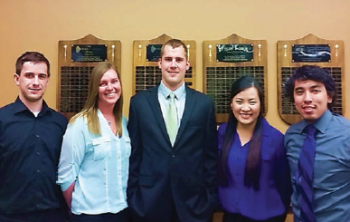
Team Members (left to right): Adam Stowe, Kasey Durkin, Parker Mojsiejenko, Stephanie Le, Jose Carmona
Dr. Daniel Morris, 3D Vision Lab: Automated 3D Model Building
With the widening availability of RGB-Depth cameras to industry and to consumers, new applications for these sensors are in high demand. World modeling is one such application and, while done before in various research projects, the process of using RGB-Depth cameras to model a space has yet to become an automated process. Automating this process would allow for numerous practical applications ranging from military use to helping those with physical disabilities.
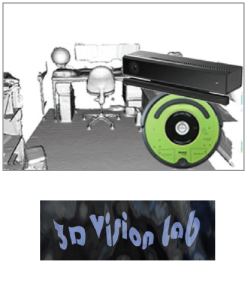 The goal of this project is to combine a robotic moving platform and a commercially available RGB-Depth camera to autonomously build a 3D model of a room. The combined device will require additional structural supports and power. A successful device will be able to localize its position when capturing images and integrate images together to build a 3D model. The robot should be able to completely map a room without getting stuck or running out of power and should do so in a timely manner.
The goal of this project is to combine a robotic moving platform and a commercially available RGB-Depth camera to autonomously build a 3D model of a room. The combined device will require additional structural supports and power. A successful device will be able to localize its position when capturing images and integrate images together to build a 3D model. The robot should be able to completely map a room without getting stuck or running out of power and should do so in a timely manner.
Several challenges had to be addressed while working on this project including integrating the various pieces of hardware together, solving the mapping and localization problem, and combining the data from the RGB-Depth sensor into a cohesive and complete 3D model in real-time.
Pictured on right: an example of a 3D model of a room, along with both the RGB-Depth sensor (Microsoft Kinect V2) and robotic platform (iRobot Create 2) used in the project.
Asante Solutions, Inc. & MSU RCPD: Accessible Insulin Pump
Diabetes is a group of common metabolic diseases in which there are high blood sugar levels over a prolonged period of time. In the United States, there are approximately 29.1 million people who have diabetes. Out of that population, 5.3 million diabetics have a form of retinopathy, which may lead to loss of vision. Diabetics use an insulin pump to balance their blood sugar levels. However, the visually impaired face hardships obtaining the information provided on the current market’s pumps. With the assistance of Asante Solutions, Inc. and Michigan State University’s Resource Center for Persons with Disabilities, the team is striving to produce an intuitive and functional pump for all users.
 An insulin pump administers insulin to the user’s body multiple times throughout each day. Vital concerns are during meals as diabetics must be aware of their insulin levels. However, blind users cannot fulfill this action if the insulin pump is not accessible. Many users require assistance and some have trained to do so through memory. The solution to the next generation of insulin pumps is evident in audibility.
An insulin pump administers insulin to the user’s body multiple times throughout each day. Vital concerns are during meals as diabetics must be aware of their insulin levels. However, blind users cannot fulfill this action if the insulin pump is not accessible. Many users require assistance and some have trained to do so through memory. The solution to the next generation of insulin pumps is evident in audibility.
To resolve this issue, the team designed an audible insulin pump that retains the simplicity and functionality of a standard insulin pump. Using a microcontroller and text-to-speech chips, the team developed a program that is capable of outputting information on the pump screen audibly. This pump design will present a foundation for the future of insulin pumps in intuitiveness, functionality, and accessibility for all users.
MSU RCPD & College of Engineering: Smart Walker Design
The Resource Center for Persons with Disabilities at MSU provides help and resources for students with disabilities. One day David, a MSU student with a visual and motoric disability was using his walker in an unknown area of campus. As a result, he did not see the flight of stairs in front of him and proceeded to fall down them. Luckily, the injuries he sustained were not major; however it got David and RCPD thinking about the possibilities of a device that could be attached to his walker and alert him of dangerous drop-offs so he would have time to stop.
 Upon David’s request for a Smart Walker Device, Stephen Blosser and our team have developed a device that will attach to David’s walker. The device will warn him of upcoming drop-offs by triggering an auditory alert system so he has enough time to stop.
Upon David’s request for a Smart Walker Device, Stephen Blosser and our team have developed a device that will attach to David’s walker. The device will warn him of upcoming drop-offs by triggering an auditory alert system so he has enough time to stop.
The Smart Walker Device will be able to extend to others in need of drop-off alert assistance due to its capability to attach to any walker. Also, once a user obtains a new walker, they will have the ability to attach it to their new walker.
A microcontroller will communicate with sensors that will be mounted on the walker to obtain the distance and set a ground reference. Once that ground reference changes from a drop-off being read, the microcontroller will trigger the auditory alert system and warn David to stop.

Team Members (left to right): Sean Moore, Yakov Kochubievsky, Jeffrey Hancock, Dominic Hill, Trevor Dirheimer
Instrumented Sensor Technology: Lightning Strike Detector, Counter and Time Log
Instrumented Sensor Technology (IST) has worked over the past 25 years developing portable dynamic measurement instrumentation for shock, vibration, etc. Their current line of instruments offers everything from low-cost shock detectors to full featured shock and vibration waveform recorders.
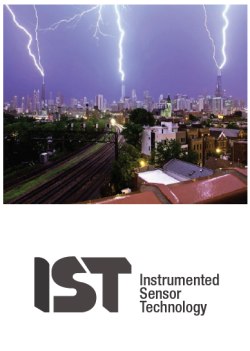 Until now IST has only dealt with shock and vibration due to a physical force instead of an electrical pulse, such as lightning strikes.
Until now IST has only dealt with shock and vibration due to a physical force instead of an electrical pulse, such as lightning strikes.
Direct lightning strikes to buildings may cause disruption to any electrical systems within the building. This can cause errors or data loss to computers that are running at the time of the strike.
Due to this issue, it is beneficial to know if and when a building is struck by lightning. This is why IST is pursuing the development of a lightning strike detector.
Currently, most lightning strike detectors on the market can detect lighting within a few miles. IST is looking to develop a device that will detect a lighting strike within a few feet. This information will help determine if a building is directly hit.
A solution to this issue is to detect a magnetic field that is induced from the lightning surge as it flows through the grounding rod of a building. When a magnetic field is detected, the device will display the time of the strike. This display will provide a maintenance technician with a time log of direct strikes, which will allow the technician to check all electrical systems.
ArcelorMittal: Crane Collision Avoidance
ArcelorMittal has been the world’s leading steel and mining company for many years. Present in over 60 countries, ArcelorMittal has established a sustainable foundation, working proficiently and focusing on the safety of their members. Priding themselves on the significantly low rate of injuries that take place inside of the facilities, ArcelorMittal has implemented their “Journey to Zero” campaign to completely alleviate any workplace incident in the future.
 In order to accomplish their “Journey to Zero,” the installation of a crane collision alert system warning an operator of any hazards, is an immediate need at the East Chicago, IN facility. Our team was given the task of designing a collision alert system that will provide an audible and/or visual alarm to the operator as the Electric Overhead Cranes (EOT) approaches a hazard at the same elevation as the crane.
In order to accomplish their “Journey to Zero,” the installation of a crane collision alert system warning an operator of any hazards, is an immediate need at the East Chicago, IN facility. Our team was given the task of designing a collision alert system that will provide an audible and/or visual alarm to the operator as the Electric Overhead Cranes (EOT) approaches a hazard at the same elevation as the crane.
Our collision avoidance system is comprised of two mechanisms: sensing technology and alert system. Using a proximity sensor, it will detect the distance between itself and another crane. Once the cranes come within a close proximity of one another, an alarm will trigger and this process will continue with a more intensified alarm every 50ft to alert the crane operator from colliding with another crane.

Team Members (left to right): Marcel Cochran, Joshua Johnson, Hang Zhao, Wenbo Gong, Le He, Keyon Clinton
ArcelorMittal Smart Gate
ArcelorMittal is in need of an efficient and robust entrance that will aid in security, safety and traffic flow. The proposed solution is to use a Matrix RFID Reader, Arduino Yun microcontroller, servo motor, and a video camera to track and secure the gate entrance. A dedicated database table will store the employees’ valid identification numbers as well as their time of entry.
 Upon entry, personnel will be required to scan either their identification badge, or a QR code which will be placed in a database of people currently in the facility. Upon confirmation, the camera will take a picture in order to verify the integrity of the employee. Upon exit, they will scan out of the gate and be removed from the currently-on-site table. In case of any emergency, a safety engineer will be able to query the database and receive a report of everyone that is currently on the plant grounds.
Upon entry, personnel will be required to scan either their identification badge, or a QR code which will be placed in a database of people currently in the facility. Upon confirmation, the camera will take a picture in order to verify the integrity of the employee. Upon exit, they will scan out of the gate and be removed from the currently-on-site table. In case of any emergency, a safety engineer will be able to query the database and receive a report of everyone that is currently on the plant grounds.
With the excessive number of trucks that ArcelorMittal receives on a daily basis, roughly 160 semi-trucks per day, and 350 employees, the gate needs to always be running smoothly.
The current “gatehouse” lacks the new technology and efficiency that is readily available in society to not only save time but track who enters and exits the plant grounds.
MSU Electrical and Computer Engineering: High Resolution Ultrasound for Telemedicine
Currently, painful joint or musculoskeletal episodes are often misdiagnosed and treated empirically with clotting factor administration or for arthritis. Often the musculoskeletal pain is caused by hemophilia which causes internal bleeding in the joints. Timely and accurate diagnosis, along with appropriate management procedure, is critical to ensure best recovery for patients with hemophilia.
 Rapid Point of Care High Resolution Ultrasound scans are highly desirable in order to diagnose musculoskeletal pain due to hemophilia or due to other joint pathology. Telemedicine and mobile collaborations technology will allow healthcare professionals to timely and accurately diagnose musculoskeletal episodes and prescribe proper management procedures. This potentially can reduce the overall cost of medical care, as well as serve as a path for remote prescription verification and proper drug administration without the need of an outpatient visit.
Rapid Point of Care High Resolution Ultrasound scans are highly desirable in order to diagnose musculoskeletal pain due to hemophilia or due to other joint pathology. Telemedicine and mobile collaborations technology will allow healthcare professionals to timely and accurately diagnose musculoskeletal episodes and prescribe proper management procedures. This potentially can reduce the overall cost of medical care, as well as serve as a path for remote prescription verification and proper drug administration without the need of an outpatient visit.
Our team is developing a system that will wirelessly transmit data from a portable ultrasound device through Wi-Fi to a base station in order to be examined by a physician or a specialist. The system accesses collected data from the ultrasound device after a patient has been scanned using the ultrasound probe. Next, it digitizes and filters the data through a microcontroller and transmits the data using an antenna. On the base station another microcontroller with a built-in antenna receives the signal and displays it on a laptop using commercial software.
Great Lakes Controls and Engineering: Screw Machine Tool Condition Monitoring
Great Lakes Controls and Engineering has identified the problem of monitoring the wear of cutting tools on a six-spindle automatic lathe.
 Faulty parts are produced when cutting tools begin to dull or spindle bearings wear beyond nominal limits. Team 10 has been tasked with creating a system to monitor tool life and identify dull tools before they begin producing faulty parts.
Faulty parts are produced when cutting tools begin to dull or spindle bearings wear beyond nominal limits. Team 10 has been tasked with creating a system to monitor tool life and identify dull tools before they begin producing faulty parts.
The system our team has designed is comprised primarily of an industrial accelerometer, an adjustable band pass filter IC, and a microcontroller. As the tool arm moves in toward the part, the mechanical resistance causes vibrations in the tool arm that can be measured in terms of acceleration. Fluctuations in acceleration are output as differences in voltage over time. The output is analyzed using the band pass filter IC and microcontroller. The system produces an output signal to the lathe’s Programmable Logic Controller (PLC).
Pictured on the right is a side view of the New Britain screw machine that the device works on. Horizontally, aluminum rods are fed through each spindle to be machined. The bulky parts on the left side of the picture are the feeders, or tool arms, which hold the tools and slide in and out during production. This is where our accelerometer will be placed.

Team Members (left to right): Richard Skrbina, Kyle Burgess, Caitlin Slicker, Chris Vogler, Ali ElSeddik
MSU Technologies: Multi-Material 3D Printer
MSU Technologies is exploring a new way to 3D print metal material. It is a plasma-based process that doesn’t require as much heat as other metal printing methods. It involves printing the metal in very small thin layers. The result is a method that may be useful in 3D printing multi-material objects.
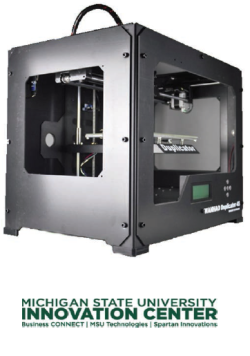 While the plasma-based metal printing process is not fully developed, a 3D printer capable of printing two materials at once is needed to eventually test the finished product. This team is modifying a dual-headed 3D printer and corresponding software to create an easy way to test the new printing process.
While the plasma-based metal printing process is not fully developed, a 3D printer capable of printing two materials at once is needed to eventually test the finished product. This team is modifying a dual-headed 3D printer and corresponding software to create an easy way to test the new printing process.
In order to make the testing process simple, a new carriage to hold the material printers will be made. This will allow one of the current plastic printers to be replaced with a metal printer.
There will also be additions to the 3D printing software. The user will be able to specify what materials they are printing. The program will be able to load some defaults based on the material. Further adjustments can be made to the defaults to get the perfect multi-material model. For example, the user may want to specify different temperatures for the different materials, or specify how thick a layer each material will create. This will help the program lay down the correct amount of material per layer. The thinness of the metal layer process means that more layers of metal must be printed for every one layer of plastic.
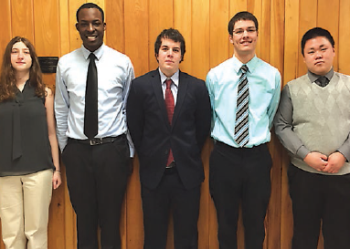
Team Members (left to right): Annalin Davis, Joshua Folks, Michael Saybolt, Matthew Luzenski, He Chen
MSU Solar Car Team: CAN Lighting System
 The goal of this project is to replace the MSU Solar Car Team’s existing central microcontroller CAN system with a simple CAN node system, while maintaining control of all of the 11 signaling lights. The amount of wiring used in this system is to be minimized and purely essential, in order to reduce unnecessary weight in the vehicle. The previous system was easy to implement, but had excessive amounts of wires connecting each signaling light to the central microcontroller. The new system will have a Microcontroller Unit (MCU) to each signaling light, and each MCU will be connected together in a daisy-chain format in order to use the minimal possible length of wire.
The goal of this project is to replace the MSU Solar Car Team’s existing central microcontroller CAN system with a simple CAN node system, while maintaining control of all of the 11 signaling lights. The amount of wiring used in this system is to be minimized and purely essential, in order to reduce unnecessary weight in the vehicle. The previous system was easy to implement, but had excessive amounts of wires connecting each signaling light to the central microcontroller. The new system will have a Microcontroller Unit (MCU) to each signaling light, and each MCU will be connected together in a daisy-chain format in order to use the minimal possible length of wire.
The figure to the right shows the final node design. The controller will take in four signals: CAN HI, CAN LOW, the power supply VDD, and the ground connection GND. The BUS will deliver a CAN signal along with the CAN HI and CAN LOW signals. These signals will be interpreted by the CAN transceiver and will be sent to the CAN controller. This interpreted signal will then be sent to the microcontroller. The microcontroller will determine whether or not to execute the command based on its individual programming. If the command is executed, then it will output a signal to the LED driver that will power the LEDs.
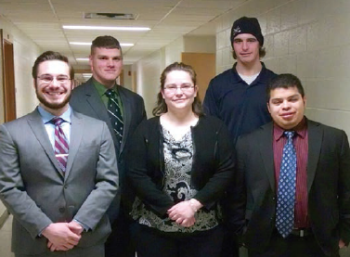
Team Members (left to right): Stephanie Stolsky, Maxx Coral, Chuck Cashen, Eleazar Gutierrez, Kyle Grager
Whirlpool Corporation: Dispenser Cup Design
The aim of this project is to prototype a completely functional, yet independent dispenser cup. The independence of this system means that no contact pads or harnesses can be used in between the appliance and the dispenser cup. Our design will not be streamlined into the market but rather it’s a proof of concept that the requirements set by Whirlpool are feasible and can be used in future works relating to our project.
 By combining an LED and a photo resistor sensor, we can detect when a liquid is placed in one of the cups on the dispenser. A solar cell panel on the outside face of the dispenser will always be exposed to the environment and convert light in the surrounding area into energy used to charge a battery which, in turn, powers the system. The last feature of the system is user-friendly LEDs to indicate which cups need to be filled depending on what cycle the user selects.
By combining an LED and a photo resistor sensor, we can detect when a liquid is placed in one of the cups on the dispenser. A solar cell panel on the outside face of the dispenser will always be exposed to the environment and convert light in the surrounding area into energy used to charge a battery which, in turn, powers the system. The last feature of the system is user-friendly LEDs to indicate which cups need to be filled depending on what cycle the user selects.
The dispenser cup we designed has three layers with different functions. The first and second layers are designed to save more water and detergent that the customers use. In order to do that, we introduced a tilted bottom with a path in the middle of each cup for detergent/bleach/softener to go into the washer. LEDs will be added to indicate the purpose for each cup, and a solar cell will be used to power up the system.
There are three different choices of microcontroller that can be used for the initial and testing: EZ430-RF2500, MSP430-G2553 and CC2500. A 9V solar cell panel, Red LEDs and photo resistors will be used in this project.
MSU Electro-Optics Laboratory: Tunable LED Light Source
Solar cells play an important role in transforming solar energy into electricity through the photovoltaic effect. As such, they have become a crucial element in providing clean renewable energy as more consumers turn away from traditional fossil fuels. The current method of testing solar cells uses a broadband light source and optical grating to change the wavelength of the light to measure the quantum efficiency of solar cells at local spots. The required components for the current method are housed in a system that is costly, cumbersome, and tabletop in size.
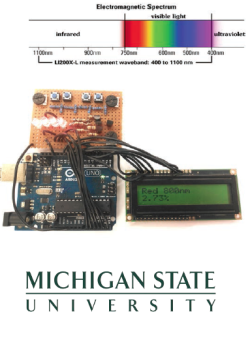 We have created a cheaper, more user-friendly testing device composed of LEDs that can be controlled via a computer to provide at least twenty-five peak wavelength points over a spectral range of 400 nm to 1100 nm. During test operation, the device will illuminate a local spot on a solar cell of area 1 mm2 area with a total power of 100 mW while the solar cell is monitored using a voltmeter to determine light-conversion efficiency. The device was requested for use in the Michigan State University Electro-Optics Laboratory to introduce students to the use of solar cells as alternative energy sources.
We have created a cheaper, more user-friendly testing device composed of LEDs that can be controlled via a computer to provide at least twenty-five peak wavelength points over a spectral range of 400 nm to 1100 nm. During test operation, the device will illuminate a local spot on a solar cell of area 1 mm2 area with a total power of 100 mW while the solar cell is monitored using a voltmeter to determine light-conversion efficiency. The device was requested for use in the Michigan State University Electro-Optics Laboratory to introduce students to the use of solar cells as alternative energy sources.
In addition, we explored additional options for our developed technology. There are potentials for commercial applications of the device as a cheaper portable alternative to current devices on the market. There is also potential in the tunable technology in greenhouse lighting and jaundice treatments.

Team Members (left to right): Isaac Davila, Ruben Valencia, John Foxworth, Cynthia Patrick, Haosheng Liu
Consumers Energy: Drone Monitoring of Power Lines
Consumers Energy is one of the nation’s largest combination utilities, providing electric and natural gas service to nearly 6.6 million of Michigan’s 10 million residents. Preserving service for its customers requires frequent power line maintenance – especially after storms. Consumers Energy desires a more efficient solution for inspection of its power lines. This project has accomplished that objective by using a drone to perform remote power line inspections.
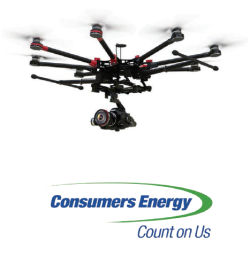 Thermal image inspection of power lines is an industry-wide method for detecting present or potential faults in power lines and other electrical equipment. Utility companies currently perform their inspections by using either handheld thermal cameras or using thermal cameras mounted to helicopters. These methods are both problematic as helicopter operation is expensive, and using handheld thermal cameras in remote areas is both dangerous and difficult.
Thermal image inspection of power lines is an industry-wide method for detecting present or potential faults in power lines and other electrical equipment. Utility companies currently perform their inspections by using either handheld thermal cameras or using thermal cameras mounted to helicopters. These methods are both problematic as helicopter operation is expensive, and using handheld thermal cameras in remote areas is both dangerous and difficult.
To address this issue, the team’s goal is to create a drone-mountable system that is capable of detecting defective power lines. Detection is performed using a thermal camera and microprocessor mounted on the drone. After a problem is detected, the system records a thermal image, a still image, a short video clip, and a GPS location of the problem area. All problem areas are subsequently plotted on Google Maps for human review, and each plot point will contain the recorded images from the video camera and thermal camera.

Team Members (left to right): Cody Wilson, Faisal Tameesh, Dan Pittsley, Mitch Johnson, Jake Hersha, Ian Meredith
